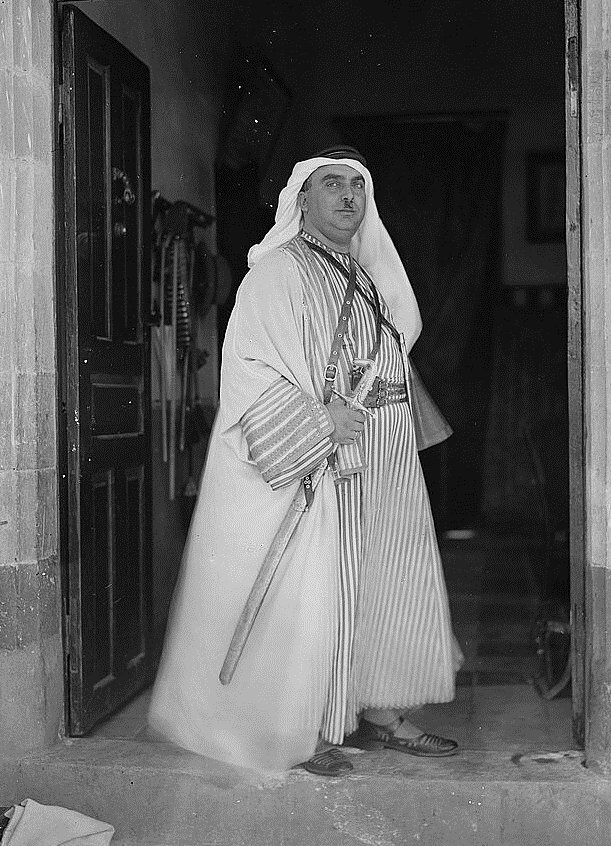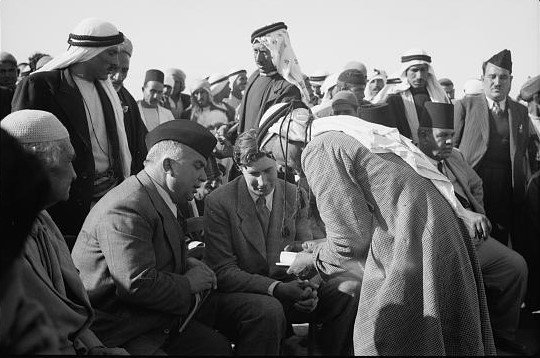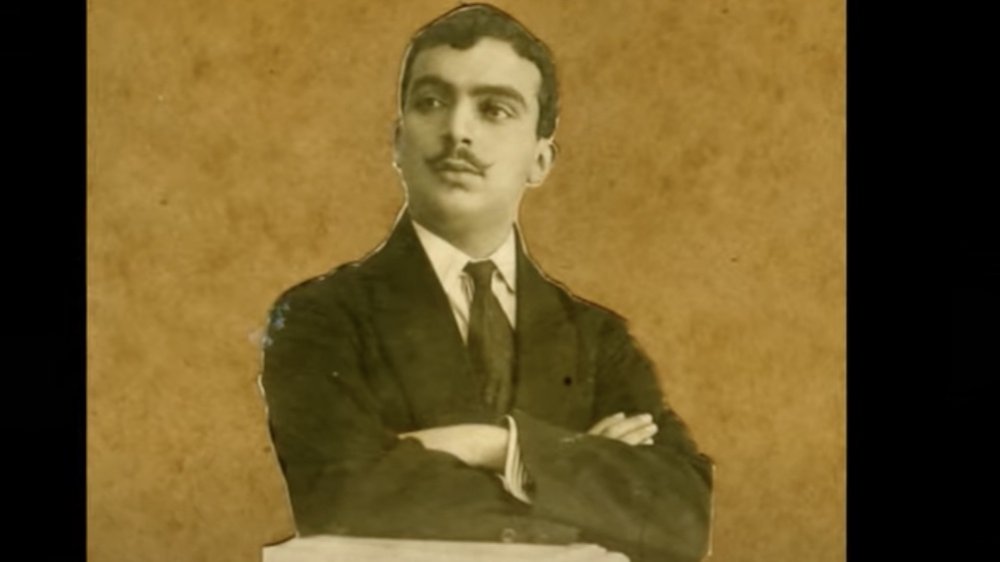Aref al-Aref (b. 1892 in Jerusalem) was a revered Palestinian journalist, historian, and politician who served as mayor of Arab Jerusalem in the 1950s. His books and articles, particularly his vivid documentation of the 1948 War and his detailed histories of Jerusalem, are a treasure for readers of the history of Jerusalem.
Childhood and Education
Aref al-Aref was born in Jerusalem in 1892. As a child, al-Aref excelled in primary school. He managed to convince his father, Shehadeh al-Aref, a modest shop owner in the Old City of Jerusalem, to send him to study in Turkey in 1906 when he was only age 14.1 He enrolled in the Marjan Preparatory School in Istanbul and transferred to the distinguished high school Numune-i Terakki, from which he graduated in 1910.2
Al-Aref enrolled in Istanbul University. His family had limited resources, and so he worked at night to cover his education expenses. He wrote for the Turkish paper Bayam. He was also one of the founders of the Arab Literary Forum (al-Muntada al-‘Arabi). This group comprised Arab visitors and residents of Turkey, most of whom had loyalty to the Ottoman Empire and who gave lectures on Arab history and Arab rights. As a fluent speaker of both Arabic and Turkish, al-Aref was soon appointed as translator for the Ottoman foreign ministry.
World War I, Detention in Russia, and a Miraculous Escape
When World War I broke out in 1914, al-Aref enlisted in the Military College in Istanbul; six months later, he was an army officer. He then joined the Ottoman army in the fight against the Russian forces at the Caucasus Front.
During the combat operations, al-Aref was captured by the Russians. He was detained, first in Russia and then in Siberia, where he was sent as a prisoner of war in Krasnoyarsk. Conditions were very harsh, and many captured soldiers died of hunger, thirst, or disease. Al-Aref remained imprisoned there for three years.
During his imprisonment, he and a Syrian prisoner, Ahmed al-Kilani, produced about 50 issues of a satirical weekly newspaper (1916–17) in Arabic, titled Naqat Allah (God’s Camel).
In the third year of his detention, al-Aref was permitted to leave prison in the early morning hours to teach a Polish colonel the Turkish language. As a result, he managed to make connections with several Russian figures. Through those interactions, he got the chance to learn Russian as well as German. In due time, he would become fluent in several languages: Turkish, Hebrew, French, English, German, and Russian.
He was sufficiently proficient in German to translate into Turkish and publish (in 1917, while in prison) Ernst Haeckel’s Die Welträtsel (The Riddle of the Universe).
In September 1918, al-Aref and 21 Arab prisoners managed to escape from the Russian prison camp. Some details of the long, arduous journey that followed the escape are documented in al-Aref’s book, My Vision (in Arabic), which was completed in 1918.
After escaping from Siberia, the prisoners took off on a circuitous route that took them from Manchuria to the Sea of Japan and the Yangtze River and eventually, several months later, to the Golan Heights. There, al-Aref met with several leaders, including the King of Greater Syria, Faisal ibn al-Husseini ibn Ali al-Hashemi. Finally, he reached Jerusalem at the end of February 1919, 10 years after he had set off to go to school in Istanbul.
Journalism
Al-Aref joined the Arab Club of Jerusalem, a political group that had influential members, such as Muslim leader and Palestinian Arab nationalist Haj Amin al-Husseini.
Al-Aref and Muhammad al-Budeiri managed and edited Southern Syria weekly newspaper, the first issue of which was published on September 8, 1919, just after the British occupation of the country. This was the first Palestinian national newspaper that was published in Jerusalem after World War I. In it, al-Aref denounced Zionism and presented his views for a united Arab national force, the Syrian Unity Party. He was explicit in his rejection of the Balfour Declaration of 1917. As a result, the British authorities frequently banned the publication of the newspaper.
On April 4, 1920, the Nebi Musa celebration turned violent around the Old City of Jerusalem, and Arabs and Jews were killed and injured. Al-Aref, Haj Amin al-Husseini, and Omar al-Barghouti were charged with inciting violence.
The three were arrested by the British authorities, and Southern Syria was forced to cease publishing.
Barghouti was imprisoned by the British authorities, but al-Aref and Haj Amin al-Husseini managed to escape to Jordan and then to Syria.
In Syria, al-Aref helped to establish the Palestinian Arab Association. He was politically active and became deputy of Jerusalem in the General Syrian Congress.
Al-Aref fled to Transjordan in 1920 when French troops occupied Damascus. He returned to Jerusalem later that year, after the British High Commissioner in Palestine, Herbert Samuel, issued a general amnesty for those charged with inciting violence during the Nebi Musa celebration. While he was allowed to return, however, he was forbidden from working in journalism and being involved in politics, and his newspaper remained banned. Instead, he served as civil servant in the British Mandate (in Transjordan and Palestine). Between 1921 and 1926, he worked as district officer of the British administration in Jenin, Nablus, Bissan, and Jaffa.
Although he was prevented from working as a journalist, al-Aref continued to write. He also campaigned against the decisions of the San Remo Conference of April 1920, which gave the French and British mandates over Syria, Lebanon, Iraq, Transjordan, and Palestine.
Al-Aref married Sa‘ima al-Burnu (from Gaza) in 1922 at the age of 30. They had five children: Samir, Farouk, Lamis, Salwa, and Farida.
Regional and Local Work
In 1926, the Mandate authorities sent al-Aref to become the ministerial secretary of the government of Transjordan, and he stayed in Amman for three years, until 1929. He held the position of secretary general under the government of Amir (prince) Abdullah ibn al-Hussein. In addition, he took on distinguished consultancy roles. He continued to advocate for Arab nationalism and openly opposed the agreement between Great Britain and the prince, which limited the sovereignty of Transjordan. He wrote a detailed diary of that period called The Diary of Aref al-Aref in the Emirate of Transjordan, one of the first political diaries of its time.
In 1929, al-Aref served as district officer in the Beersheba subdistrict and later in Gaza. During that time, he wrote books about Bedouin law (1933) and the history of Beersheba (1934). Later he would write about the history of Gaza (1943) and al-Haram al-Sharif (1947).
In 1943, al-Aref took on the role of district officer in the Ramallah subdistrict (within the Jerusalem district). He became assistant to the British Commissioner of the Jerusalem district, a position he held until 1948.
In 1949, after the city was divided by the war, King Abdullah of Jordan appointed al-Aref as head of the municipality of Arab (later to become “East”) Jerusalem. In 1950, he was elected as mayor of Arab Jerusalem until 1955. He was also appointed as minister of public works.
Documentation of the Nakba and Other Writings
Al-Aref was a meticulous writer whose books addressed the geopolitical as well as social aspects of Palestine.
Probably his most famous book is his vivid documentation of the events of the 1948 War. Written in Arabic between 1956 and 1961, the seven-volume al-Nakba: Nakbat Bayt al-Maqdis wa-l-firdaws al-mafqud (The Catastrophe: The Catastrophe of Jerusalem and the Lost Paradise) recorded the events of the war with accuracy, detail, and objectivity. It is still regarded as one of the most important references on the Nakba, as it is based not only on his own experience but on personal accounts gathered from interviews he conducted.
In the first four parts, al-Aref built the foundation of the book in relation to the Nakba, whereas the fifth part provided international and regional documents as well as valuable polls relating to the 1948 War. In the sixth part, al-Aref documents the names of dead noncombatants as well as the army casualties killed between 1948 and 1950. The seventh and last part, added later by al-Aref’s daughter Farida al-Amad, included photos of events. As prominent Palestinian historian and researcher Bayan Nuwayhed al-Hout described him: “Aref al-Aref was, rightfully, the historian of the Nakba.”3
Al-Aref did much of his initial writing when he was mayor of Jerusalem (1951). After resigning from the government (in 1955), he concentrated most of his time and efforts on research and writing.
Al-Aref described himself not as a historian but rather as a narrator who carefully noted down events, names, and places. He was an eyewitness who recorded his own and other firsthand accounts of the war and conducted interviews with diverse individuals and officers.
Social Work
In addition to his political roles and writing, al-Aref was involved in social work. He chaired the Wounded Veterans League in Jerusalem and served as a trustee of the Family Revival Society (Jam‘iyyat In‘ash al-Usra), led by women’s rights activist Samiha Khalil. Al-Aref was a fervent supporter of women’s rights; he advocated gender equality and the empowerment of women.
In the 1960s, he was appointed director of the Palestine Archaeological Museum in Jerusalem just outside the Old City, which was established in 1938 and brought to life through the assistance of the US-based Rockefeller Foundation.4
“My Father Adored Jerusalem”
Al-Aref loved everything about Jerusalem—its beauty, gentle breeze, even its soil quality. Besides his dedication to write the details of al-Nakba, he endorsed much effort to write about the history of Jerusalem and some of its holy sites. In an in-depth profile of al-Aref produced by al-Ghad TV in 2019, his daughter Farida recalled:
I remember when he was writing his detailed account of the history of Jerusalem, he would leave home at 3:30–4:00 a.m. when the streets were empty. He would go up the stairs that the municipality of Jerusalem set up for him so as to read what’s written on the stones and record the information. He put every effort to document Jerusalem and to display the fabrications that falsified its foundations.5
She recalled that her father got really ill when Israel claimed control over Jerusalem following the 1967 War. Israeli mayor of Jerusalem Teddy Kollek invited al-Aref to attend an official event, which he declined; he was appalled at the idea of the occupier sitting where the local inhabitants should be.6
Al-Aref bought a house in 1948 in the al-Baq‘a neighborhood of the New City of Jerusalem. However, he was not able to live in it because of the war. After the 1967 occupation, he was able to visit his house, but he found that it was occupied by an Israeli woman, and she screamed at him to leave. He was thus forced to live the rest of his days in al-Bira (Ramallah) instead of his beloved Jerusalem.
Death
Al-Aref died at his home in Ramallah on July 30, 1973, at the age of 81.
Awards
In 1990, the Palestine Liberation Organization (PLO) posthumously awarded al-Aref the Jerusalem Medal for Culture, Arts, and Literature.
In March 2010, the Jerusalem Youth Parliament in Jerusalem launched a youth campaign with Aref al-Aref as its persona theme. The campaign aimed to foster the role of youth of maintaining their Palestinian history and culture. As part of the campaign, the youth asked the Ministry of Education to name a high school in Jerusalem for him. They bestowed on him the title “Preserver of Memory.”7
Selected Works
al-Qada bayn al-Badu [The law among the Bedouin]. Jerusalem: Bayt al-Maqdis, 1933; Beirut: Arab Institute for Research and Publishing, 2001.
Tarikh Beer al-Sabe‘ wa-Qaba’iluha [The history of Beersheba and its tribes]. Jerusalem: Bayt al-Maqdis, 1934; Cairo: Madbooli Library, 1999.
Ru’yay [My vision]. 1st ed. Jerusalem: Franciscan Press, 1943; 2nd ed. with a new introduction. Beirut: Dar al-Rihani Printing Corporation Publishing and Distribution, 1957.
al-Mujiz fi tarikh ‘Asqalan [A brief history of ‘Asqalan]. Jerusalem: Bayt al-Maqdis, 1943.
Tarikh Ghazza [The history of Gaza]. Jerusalem: Dar al-Aytam al-Islamiyya [The Islamic Orphanage], 1943.
Bedouin Love, Law and Legend: Dealing Exclusively with the Badu of Beersheba, in collaboration with Harold W. Tilley. Jerusalem: Cosmos Pub. Co., 1944; New York: AMS Press, 1974.
Tarikh al-Haram al-Qudsi [The history of the Jerusalem sanctuary]. Jerusalem: Dar al-Aytam al-Islamiyya al-Sina‘iyya [Industrial Islamic Orphanage], 1947.
The Dome of the Rock and Other Muslim Sanctuaries in the Haram of Jerusalem: History and Guide, in collaboration with A. Willard Jones. Jerusalem: Jerusalem Commercial Press, 1951.
Tarikh al-Quds [The history of Jerusalem]. Cairo: Dar al-Ma‘arif, 1951.
The History of the Dome of the Rock and the al-Aqsa Mosque, and a Short Survey of the History of Jerusalem. [In Arabic.] Jerusalem: al-Andalus Library, 1955.
al-Nakba: Nakbat Bayt al-Maqdis wa-l-firdaws al-mafqud: 1947–1952 [The Catastrophe: The Catastrophe of Jerusalem and the lost paradise: 1947–1952]. 1st ed. 6 vols. Beirut and Sidon: al-Maktaba al-‘Asriyya, 1956–61; 2nd ed. 3 vols. Foreword by Walid Khalidi. Beirut: Institute for Palestine Studies, 2012.
al-Mufassal fi tarikh al-Quds [A history of Jerusalem: A detailed account of the holy city]. Jerusalem: al-Andalus Library, 1961; Beirut: Arab Institute for Research and Publishing, 2005.
al-Nakba fi suwar: Nakbat al-‘Arab fi Filastin [The Catastrophe in photographs: The Catastrophe of Palestine’s Arabs]. Beirut: Dar al-‘Ilm li-l-Malayin, 1961.
Aref al-Aref’s Papers. Beirut: Palestinian Liberation Organization (PLO) Research Center, 1973.
Sources
Encyclopedia Palestina. “Aref al-Aref (1892–1971).” [In Arabic.] Accessed October 13, 2021.
al-Ghad TV. “Jerusalem Faces: Aref al-Aref: The Sheikh of Palestinian Historians.” [In Arabic.] January 3, 2019.
al-Hout, Bayan Nuwayhed. “The Palestinian Historians and the Nakba.” [In Arabic.] Institute for Palestine Studies 89 (Winter 2012): 59.
Jubeh, Nazmi. Lifta: Register of a People, History, Cultural Heritage, and Struggle. [In Arabic.] Institute for Palestine Studies, 2020.
al-Khalidi, Walid. “Aref al-Aref, the Nakba, and the Lost Paradise.” [In Arabic.] Journal of Palestine Studies (Essays for the Institute for Palestinian Studies), no. 90 (Spring 2012).
Marefa. “Aref al-Aref.” [In Arabic.] Accessed October 10, 2021.
Palestinian Journeys. “Aref al-Aref.” Accessed October 2, 2021.
Tamari, Salim. “With God’s Camel in Siberia: The Russian Exile of an Ottoman Officer from Jerusalem.” Jerusalem Quarterly 35 (2008): 31–50.
Wafa Agency. “Aref al-Aref: The Sheikh of Palestinian Historians.” [In Arabic.] December 20, 2018.
Wikipedia, s.v. “Aref al-Aref.” Last modified September 24, 2021, 19:21.
Notes
Meanwhile, Salim Tamari notes that he was 16: Salim Tamari, “With God’s Camel in Siberia: The Russian Exile of an Ottoman Officer from Jerusalem,” Jerusalem Quarterly 35 (2008): 34.
Sources provide different dates for his travel to Istanbul; this account draws on the dates provided in an article by Walid Khalidi and by Aref al-Aref’s daughter during a TV interview.
Bayan Nuwayhed al-Hout, “The Palestinian Historians and the Nakba,” Institute for Palestine Studies, no. 89 (Winter 2012): 59.
After Israel occupied East Jerusalem 1967, the state took over the museum and renamed it the Rockefeller Archeological Museum. The museum houses a large collection of artifacts unearthed in the excavations conducted in Mandate Palestine in the 1920s and 1930s. Today the museum is under the management of the Israel Museum.
al-Ghad TV, “Jerusalem Faces: Aref al-Aref: The Sheikh of Palestinian Historians” [in Arabic], January 3, 2019, translation by the Jerusalem Story Team.
al-Ghad TV, “Jerusalem Faces.”
Jerusalem Youth Parliament YouTube channel.



